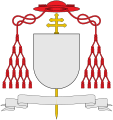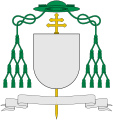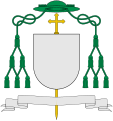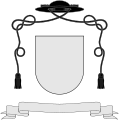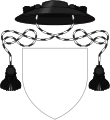Helmet (heraldry)
| Part of a series on |
| Heraldic achievement |
|---|
| External devices in addition to the central coat of arms |
|
t |
In
Open-visored or barred helmets are typically reserved for the highest ranks of nobility, while lesser nobility and burghers typically assume closed helms.[2] While these classifications remained relatively constant, the specific forms of all these helmets varied and evolved over time.[2]
In ecclesiastical heraldry, bishops and other clergy use a mitre or another rank-appropriate ecclesiastical hat in place of a helmet.[3]
History

The evolution of heraldic helmet shape followed the evolution of helmet design, especially
The practice of indicating rank through the display of barred or open-face helmets appears around 1615.[4] As jousting with lances was supplanted by tourneying with maces, the object being to knock the opponent's crest off his helmet, the fully enclosed helmet gave way to helmets with enlarged visual openings with only a few bars to protect the face. These barred helmets were restricted by the imperial chancellery in Vienna to the nobility and certain doctors of law or theology, while the jousting helm was freely adopted by anyone.[5]
The direction a helmet faces and the number of bars on the grille has been ascribed special significance in later manuals, but this is not a period[clarification needed] practice.[6] A king's helmet, a golden helmet shown affronté with the visor raised, crowned with a royal crown, became adopted by the kings of Prussia.[6]
Historically[clarification needed], the helmet was not specifically granted in an achievement of arms, but was naturally assumed by appropriate rank as a matter of "inherent right", so a helmet with torse and mantling would not be misplaced even above a shield which had no crest to place above it.[7] When multiple crests need to be depicted, the convention in English heraldry is to draw the crests above a single helmet, each being separated from it, while in German heraldry, where multiple crests appear frequently after the 16th century, each crest is always treated as inseparable from its own helmet and turned in agreement with the helmet.[8]
In continental Europe, multiple helmets were usually turned inward, with the center helm (if an odd number) turned affronté; while in Scandinavian heraldry the helmets were usually turned outward.[9] Heraldic combinations were driven to extremes in the 18th century, e.g. the arms of the last
By traditions
General
-
Open or barred helmet, reserved for members of the nobility
-
Closed or tilting helm, used by medieval
United Kingdom
The usage of heraldic helmets in Britain is as follows: gold helmet with bars for the royal family; silver helmet with gold bars for
-
Monarch and family
-
Peer
-
Baronet or Knight
-
Esquire or Gentleman
France
The French heraldic tradition for helmets also attempted in the later period to standardize the shape of the helmet depending on the rank, with for instance helmets turned to the left (i.e., pointing to the right) for bastards, or open golden helmets for kings and emperors (the sovereign must see and know everything).[12]
Russia
The norms of
In the modern
Both in Imperial and republican Russian heraldry, the direction of the helmet plays no role: whether the helmet is portrayed affronty or turned to the right depends on the shape of the crest.
-
Open Western helmet: coat of arms of thePushkinfamily.
-
Closed Western helmet: coat of arms of the Skornyakov family.
-
Aristocratic yerikhonka: lesser coat of arms of the Russian Empire.
-
Aristocratic misyurka: coat of arms of theKazakh Chingis family].
-
Commoner ethnic helmet: coat of arms of Vladimir Kopelev, knight of the For Merit to the Fatherland order.
-
Commoner Western helmet: coat of arms of Nikolai Likhachev, citizen of Peterhof.
Canada
In Canadian heraldry, helmets play a little role and are not blazoned; therefore, the armiger can display their helm in whatever style they choose. One notable example of a non-traditional helmet used in Canadian heraldry is the arms of Julie Payette, a former governor general of Canada, which bears an astronaut's helmet as the helm.[15] Other examples include nasal helmets,[16] Corinthian helmets,[17] parka hoods,[18] and United Nations peacekeeping helmets.[19]
-
The armorial achievement of Julie Payette notably features an astronaut helmet, which would be considered nontraditional in most other heraldic traditions.
Belgium
In Belgian heraldry, barred helms are most commonly used, and are not reserved for the nobility like in some jurisdictions. They most often have gold bars, as well as a gold collar and trim. They are often lined and attached.[20]
-
Barred helm with gold bars, collar, and trim.
-
All silver barred helm.
-
Jousting or tourney helms are sometimes also used, but are rarer. They are the only alternative accepted by the Council of Heraldry and Vexillology to the barred helmet.[21]
Ecclesiastical
In the
-
Galero gules with fifteen tassels per side, used by cardinals in place of a helmet (and patriarchal cross)
-
Galero vert with ten tassels per side, used by archbishops in place of a helmet (and patriarchal cross)
-
Galero vert with six tassels per side, used by bishops in place of a helmet (and single-barred cross)
-
Galero sable with one tassel per side (and blank shield), used by armigerous priests in place of a helmet
In the same way, clerics of the Anglican Communion entitled to a coat of arms use a similar black hat in place of a helmet.
-
Hat sable with cords purpure and three tassels per side, used by Anglican archdeacons in place of a helmet
-
Hat sable with cords purpure and three tassels gules per side, used by Anglican deans in place of a helmet
-
Hat sable with three tassels gules per side, used by Anglican canons in place of a helmet
-
Hat sable with cords sable and argent and one tassel sable per side, used by Anglican priests in place of a helmet
Notes
- ^ Woodcock (1988), p. 202.
- ^ a b c Fox-Davies (1909), p. 303.
- ^ Woodcock (1988), p. 75.
- ^ Fox-Davies (1909), p. 319.
- ^ Neubecker (1976), pp. 148, 162.
- ^ a b Neubecker (1976), p. 148.
- ^ Fox-Davies (1909), p. 58.
- ^ Fox-Davies (1909), pp. 322-323.
- ^ Fox-Davies (1909), p. 323.
- ^ Neubecker (1976), p. 165.
- ^ Iain Moncrieffe; Don Pottinger (1953). Simple Heraldry Cheerfully Illustrated. Thomas Nelson and Sons. p. 58.
- ^ "Héraldique : base de données". www.euraldic.com. Retrieved 28 March 2024.
- ^ Структура герба: российская практика. Медведев М.Ю. Геральдика // Специальные исторические дисциплины. СПб, 2003.
- ^ Основные принципы оформления личного герба в современной России. Гражданская геральдика сегодня.
- ^ Payette, Julie (Individual), Public Register of Arms, Flags, and Badges of Canada
- ^ Wallace, Stephen Gregory (Individual), Public Register of Arms, Flags and Badges of Canada
- ^ Eppich, Helmut Michael (Individual), Public Register of Arms, Flags, and Badges of Canada
- ^ Irniq, Peter (Individual), Public Register of Arms, Flags and Badges of Canada
- ^ Munn, Kenneth Angus (Individual), Public Register of Arms, Flags, and Badges of Canada
- ^ Council of Heraldry and Vexillology handbook (Read online)
- ^ Council of Heraldry and Vexillology handbook (Read online)
References
- ISBN 1-4179-0630-8
- ISBN 0-07-046308-5
- ISBN 0-19-211658-4




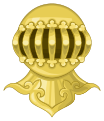




![Closed Western helmet: coat of arms of the Skornyakov family [ru].](http://upload.wikimedia.org/wikipedia/commons/thumb/b/b3/Skornyakov_Coat_of_Arms.jpg/120px-Skornyakov_Coat_of_Arms.jpg)

![Aristocratic misyurka: coat of arms of the Kazakh Chingis family [ru].](http://upload.wikimedia.org/wikipedia/commons/thumb/d/d2/Chingis_Coat_of_Arms.jpg/109px-Chingis_Coat_of_Arms.jpg)




![Jousting or tourney helms are sometimes also used, but are rarer. They are the only alternative accepted by the Council of Heraldry and Vexillology to the barred helmet.[21]](http://upload.wikimedia.org/wikipedia/commons/thumb/b/b8/Meuble_h%C3%A9raldique_casque_joute.svg/85px-Meuble_h%C3%A9raldique_casque_joute.svg.png)
